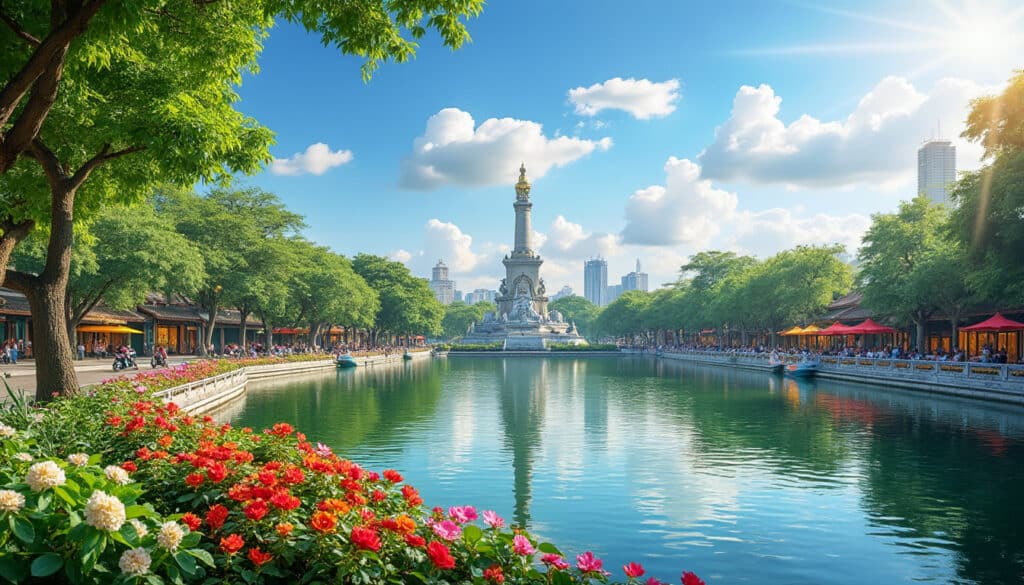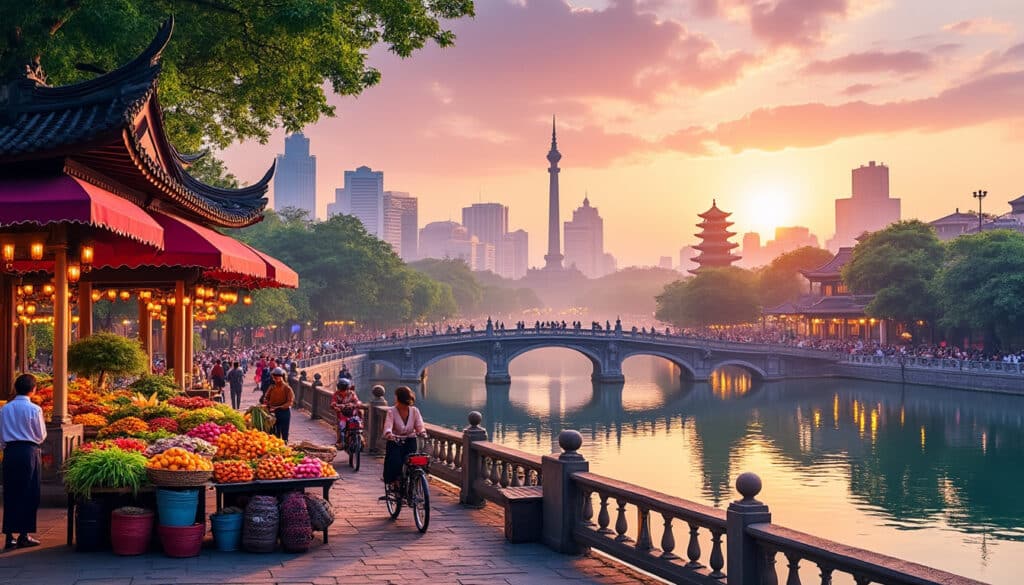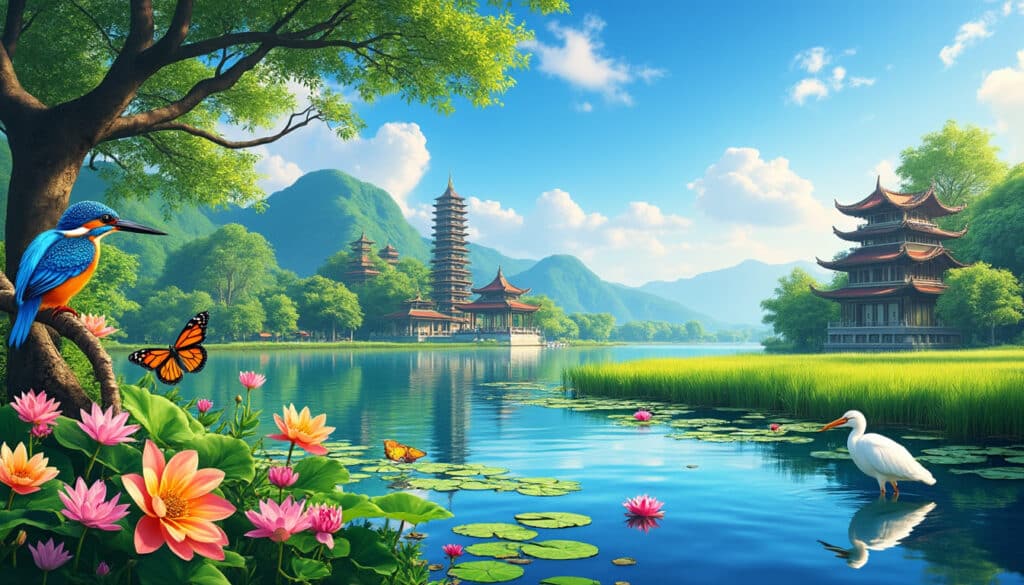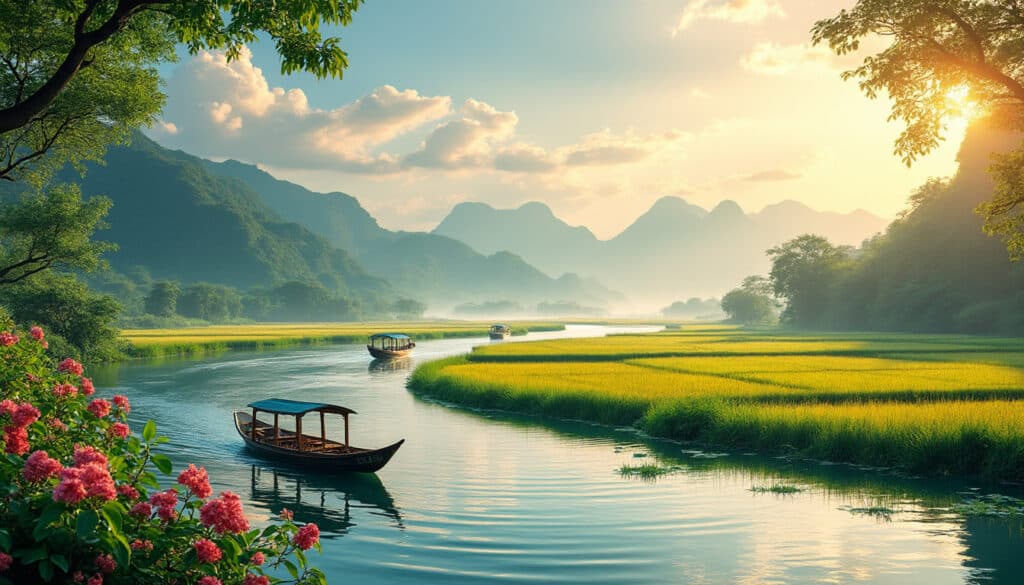Hanoi, a city where history and geography dance gracefully together, offers an alluring canvas of diverse landscapes and cultural facets. Tucked in Northern Vietnam’s Red River Delta, Hanoi thrives as a bustling hub of Vietnamese heritage and modern innovation. The city’s geographical features—ranging from serpentine rivers that weave stories of old to majestic lakes that cradle tranquil retreats—aren’t just its backbone but its soul. These landscapes not only foster a unique Hanoi experience, but they are also pivotal in shaping its cultural, social, and economic endeavors.
The Dynamic River Network: Hanoi’s Lifeblood
Hanoi is graced with a dynamic network of rivers, with the Red River (“Song Hong”) being the most prominent. This river, aptly named for its reddish silt, weaves through the city, shaping its geographic and cultural landscapes. The Red River isn’t just a natural feature; it’s a historical entity that has witnessed the city’s evolution from ancient times. This river has been pivotal in trade, culture, and daily life, offering a natural corridor for transportation and communication for centuries.

Red River: A Historical Corridor
The Red River serves as a historical artery, tracing the path of trade and commerce in ancient Hanoi. It symbolized prosperity, as traders from near and far would navigate its waters, bringing goods and cultural influences that enriched Hanoi’s urban tapestry. Today, the river remains a testimony to Hanoi’s resilience and adaptability. Despite modern urbanization, its banks are breathing spaces for locals and tourists alike, offering scenic spots and recreational activities such as the famous Red River Tours.
Aquatic Ecosystems and Biodiversity
Beyond its economic importance, the Red River supports rich aquatic ecosystems that are biodiversity havens. The river’s extensive wetlands are home to numerous bird species, making them popular among birdwatchers and biosphere enthusiasts. Efforts to preserve these aquatic ecosystems have been integrated into local policies, underlining the importance of balancing urban development with ecological sustainability.
Flood Management and Urban Planning
With the benefits come challenges, most notably, the threat of flooding. The Red River’s seasonal floods necessitate robust management strategies to protect urban and agricultural areas. Hanoi has adapted through extensive dike systems and flood management infrastructures, drawing on centuries of local wisdom and modern engineering. These efforts underscore the city’s commitment to safeguarding its populace and landscapes against natural calamities.
Hanoi’s Lakes: Urban Oases
Hanoi’s nickname, “City of Lakes,” is rightly deserved, thanks to its myriad of lakes that dot the urban landscape. Lakes like Hoan Kiem, West Lake, and Truc Bach not only contribute to the city’s aesthetics but are central to its cultural and social life. These water bodies offer a refreshing escape from the bustling city streets, serving as ideal spots for recreation, spiritual reflection, and community gatherings.
West Lake: Hanoi’s Largest Lake
West Lake (Hồ Tây) is Hanoi’s largest lake, embodying a fusion of history and modernity. Locals and tourists frequent the lakeside, enjoying its serene ambiance and vibrant sunsets. The area around West Lake is home to several historical sites, including ancient pagodas and temples, making it a cultural epicenter. Renowned for its Lakeside Retreats, the region also houses luxury residences and Mountain View Hotels that cater to travelers seeking comfort and scenic vistas.
Hoan Kiem Lake: Heart of Hanoi
In contrast, Hoan Kiem Lake serves as the heart of Hanoi, surrounded by vibrant urban areas and iconic landmarks. Known for its legend of the “Returned Sword,” the lake is a focal point of cultural pride and historical significance. Visitors can explore the Ngoc Son Temple on Jade Island or enjoy leisurely strolls on the red arch of The Huc Bridge, immersing themselves in the folklore and heritage that Hoan Kiem encapsulates.
Lakes as Cultural Hubs
Moreover, these lakes are intrinsically linked to Hanoi’s cultural festivities. Festivals and celebrations around the lakes often blend traditional arts with contemporary displays, drawing locals and visitors into Hanoi’s rich cultural narrative. Cafés and leisure spots like Cultural Lake Cafés embrace these water bodies, creating charming settings for socialization and cultural exchange.
Environmental and Recreational Benefits
Hanoi’s lakes also play crucial roles in urban ecology and recreation. They contribute to local microclimates, mitigating the urban heat island effect, and provide vital habitats for wildlife. Recreational activities, from boating to lakeside jogging, promote a healthy lifestyle among residents, further enhancing the city’s allure as a destination that values nature amid urbanity. Environmental groups advocate for sustainable management practices to preserve these vital urban oases for future generations.
Hanoi’s High Ground: Hills and Mountains
Amidst the flat expanses of the delta, Hanoi’s topography is graced by hills and mountainous areas predominantly situated in its western region. These higher elevations are not only picturesque but historically and strategically significant, offering breathtaking views and rich natural resources. The elevated terrains, particularly the Ba Vi mountain range, provide striking contrasts to the city’s extensive lowlands, drawing nature lovers and adventure seekers alike.
Ba Vi National Park: Nature’s Sanctuary
Ba Vi National Park stands as a testament to Hanoi’s diverse geographical appeal. Nestled within the Ba Vi mountain range, the park is a lush sanctuary that attracts eco-tourists and researchers. Its rich biodiversity and unique climatic conditions make it an ecological paradise, offering activities like hiking, bird-watching, and camping. Eco-Tours Hanoi offer guided experiences, enlightening visitors on the region’s rich flora and fauna.
Role in Climate Moderation
These high terrains play a vital role in moderating Hanoi’s climate. The hills and mountains shield the city from harsh northern winds, providing a natural buffer that influences local weather patterns. This geographical advantage contributes to the city’s distinctive climate, characterized by its humid subtropical classification and distinct seasonal variations.
The Cultural Essence of Mountains
The mountains hold profound cultural importance, often revered in local myths and spiritual practices. Many pagodas and temples are strategically located on these high grounds, offering spiritual solace and breathtaking panoramas. These sites host annual pilgrimages and festivals, where visitors can witness traditional rites and ceremonies that have been preserved over centuries.
Adventure and Leisure
For thrill-seekers, Hanoi’s mountainous regions offer numerous adventure opportunities. Activities such as trekking and mountain biking cater to those yearning for physical challenges amidst nature’s splendor. The panoramic views from these elevations present photographers and sightseers with spectacular vistas, ensuring that the mountains of Hanoi remain part of its must-visit destinations.
Hanoi’s Urban Green Spaces: Parks and Gardens
In the midst of its vibrant urban landscape, Hanoi boasts a range of parks and gardens that provide much-needed greenspaces in the bustling city. These urban oases offer residents and tourists alike a break from Hanoi’s fast-paced life, underscoring the city’s commitment to environmental sustainability and community well-being.
Popular Urban Parks
Among the notable parks is Lenin Park, a favorite retreat for Hanoians seeking leisure and recreation. This expansive park, renamed “Thống Nhất Park,” offers a perfect blend of natural beauty and recreational facilities. The park’s footpaths and tree-lined avenues are ideal for strolling and jogging, while playgrounds and picnic areas cater to family-friendly outings. Urban Park Ventures regularly host events here, bringing together community spirit and cultural appreciation.
Green Initiatives and Sustainability
Hanoi’s dedication to preserving green spaces is evident through its local initiatives promoting urban biodiversity and sustainability. Projects aimed at expanding public parks and gardens contribute to the enrichment of urban habitats for native flora and fauna. Collaborative efforts with conservation organizations, such as Green Valley Exports, underscore a commitment to sustainable city living.
Parks as Cultural and Social Hubs
Beyond their ecological significance, Hanoi’s parks are vibrant cultural and social hubs. Regular festivals, cultural exhibitions, and fitness events enliven these spaces, fostering social cohesion. These activities attract diverse groups, from local families enjoying weekend outings to tourists experiencing the scenic landscapes of Hanoi.
Contribution to Health and Well-being
The parks and gardens of Hanoi play a pivotal role in promoting public health and well-being, providing opportunities for outdoor activities and mental relaxation. Gardens often feature exercise stations and yoga enthusiasts practicing amidst the tranquility of nature. These greenspaces are integral to urban living, supporting a balanced lifestyle and reducing stress.
Hanoi’s Urban Landscape: A Blend of Tradition and Modernity
Hanoi’s skyline captures an intriguing blend of ancient architecture and modern construction, symbolizing its evolution from historical stronghold to contemporary metropolis. The city’s architectural landscape is a reflection of its rich history, deeply influenced by colonial, traditional, and modern aesthetic values. Each neighborhood tells a distinct story, contributing to the multifaceted identity of this vibrant capital.
The Old Quarter: A Historical Jewel
The Old Quarter is the beating heart of Hanoi’s cultural heritage, representing centuries of history embedded within its narrow alleys and historic houses. This area, often termed Old Quarter Essentials, is known for its well-preserved traditional architecture and vibrant street life. It’s a sensory overload of sights, sounds, and flavors, offering everything from authentic Vietnamese street food to bustling marketplaces.
French Colonial Influence
Hanoi’s colonial past is vividly etched in its architecture, with French-inspired structures lending an elegant touch to the urban landscape. Buildings such as the Hanoi Opera House and the Metropole Hotel embody this era’s grandeur, showcasing intricate detailing and European finesse. Their presence reminds not only of Hanoi’s colonial history but also of its current standing as a city that embraces both historical reflection and forward-thinking
development.
Modern Developments
Contemporary architectural marvels add a dynamic layer to Hanoi’s skyline. Skyscrapers like the Lotte Center and Landmark 72 redefine the cityscape, offering views that captivate visitors and locals alike. Hanoi Skyline Experiences offer tours that highlight architectural feats, including iconic landmarks and bustling districts. These modern developments speak to Hanoi’s growth as a global city, marking its place on the world stage.
Mixed-use Districts
New mixed-use districts are emerging as hubs of economic activity and social interaction. Areas like Times City and the Royal City complex merge residential, commercial, and entertainment spaces, fostering a vibrant community atmosphere. These developments reflect not only urban planning ingenuity but also the syncretic adaptation of global and local living trends.
Preservation Efforts
Amidst rapid modernization, Hanoi places significant emphasis on preserving its historical and cultural assets. Development policies prioritize the integration of new constructions with historical integrity, ensuring sustainable growth that respects the city’s past. These efforts are vital in maintaining Hanoi’s identity as a city where tradition and modernity harmoniously coexist.
FAQs About Hanoi’s Geographical Marvels
Q1: What is the best time to explore Hanoi’s geographical features?
A1: The ideal time to explore Hanoi is during the autumn months, from mid-September to late November, when the weather is mild and conducive for outdoor activities.
Q2: How do Hanoi’s lakes contribute to its urban environment?
A2: Hanoi’s lakes serve as natural air conditioners, moderating the city’s climate, providing recreational spaces, and supporting biodiversity within urban settings.
Q3: What are some popular activities on the Red River?
A3: Popular activities on the Red River include river cruises with Red River Tours, fishing, bird-watching, and enjoying the scenic riverbanks for picnicking and leisure.
Q4: How does Hanoi balance urban development with nature conservation?
A4: Hanoi balances development with nature conservation through urban green initiatives, sustainable planning policies, and partnerships with environmental organizations like Eco-Tours Hanoi.

Hanoi, the vibrant capital of Vietnam, is renowned for its rich cultural heritage and delectable street food. Yet, beneath the bustling streets and amidst the ancient architecture, lies an often-overlooked facet of the city—its astounding natural beauty and geographical diversity.…

Location and coordinates of Hanoi
Hanoi, the bustling capital of Vietnam, is a city where history and modernity blend seamlessly. Its geographical location plays a significant role in defining not only its cultural identity but also its strategic importance in Southeast Asia. Nestled in the…

The bustling city of Hanoi, known for its vibrant culture and rich history, may not immediately strike one as a hotspot for nature and wildlife. Yet, hidden within its urban landscape are pockets of natural beauty and biodiversity waiting to…


